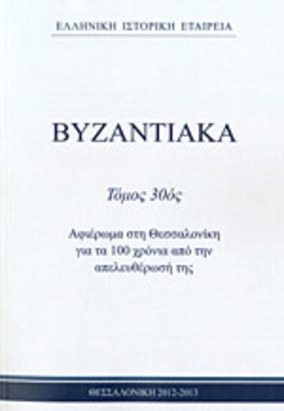Ιστορικο-γεωγραφικές αναφορές και χαρτογραφικές σημάνσεις της Θεσσαλονίκης στην ύστερη αρχαιότητα
Part of : Βυζαντιακά ; No.30, 2012, pages 11-43
Issue:
Pages:
11-43
Parallel Title:
Historical-Geographical references and cartographic semiosis of Thessaloniki during the late antiquity period
Section Title:
Αφιέρωμα στη Θεσσαλονίκη για τα 100 χρόνια από την απελευθέρωσή της
Author:
Abstract:
The aim of this paper is the study of historical-geographical information contained in "geographic" texts and cartographic signs relating to the city of Thessaloniki, between the 2nd and the 8th centuries AD. The historical context chosen for the purposes of the study is Late Antiquity, i.e. the transition from post-classical antiquity to the medieval period, mainly in the Mediterranean regions, and covers the period from 150 to 750 AD. The object of the study is examined through a textual and cartographical corpus, which comprises the "geographical" knowledge and perception of Thessaloniki in this period. The final goals of the study are to contribute to the clarification of the "geographical" conception of Thessaloniki in Late Antiquity and to clarify the deeper understanding of the spatial ideologies and practices of the societies which produced these texts. The textual corpus is made up of texts of descriptive geography, geographic encyclopedias, written and painted itineraries and travel and administrative lists, which were all produced in this historical period in areas under the jurisdiction of the Roman Empire. The Greek texts were selected using the electronic database Thesaurus Linguae Graecae (TLG), while for Latin texts, the Packard Humanities Institute database (PHI) was used. Every text is examined in a communication context that gathers information about the author, the specific textual production and the receiver of the text. The examination of the references related to Thessaloniki has detected intratextual references to variations of the name and the distinctive features related to the city. The process of identification of the qualities attributed to Thessaloniki follows a methodology which uses a careful reading of the textual data and the nota- tion of any possible reference to the city and its meanings. The "isotopies" detected in this way are organized into data tables, which collect and classify the information, creating opportunities for intertextual comparison and analysis of the distinctive features. In the same way, the cartographic semiosis of Thessaloniki was tested for the name and the graphic symbolism that ac- companies it, in the context of the broader representation, the producer and the user of the spatial message. Three main semantic attributes, namely the words "πόλις, oppidum, civitas", are identified and their meanings are examined diachronically. The absence of any reference in the texts concerning the spatial structure and the monumental armature of Thessaloniki is finally discussed, in order to add extratextual information about the material culture and better evaluate the hidden urban model of the city of Late Antiquity.
Subject (LC):
Notes:
Περιέχει πίνακα, χάρτη, εικόνες και σημειώσεις




